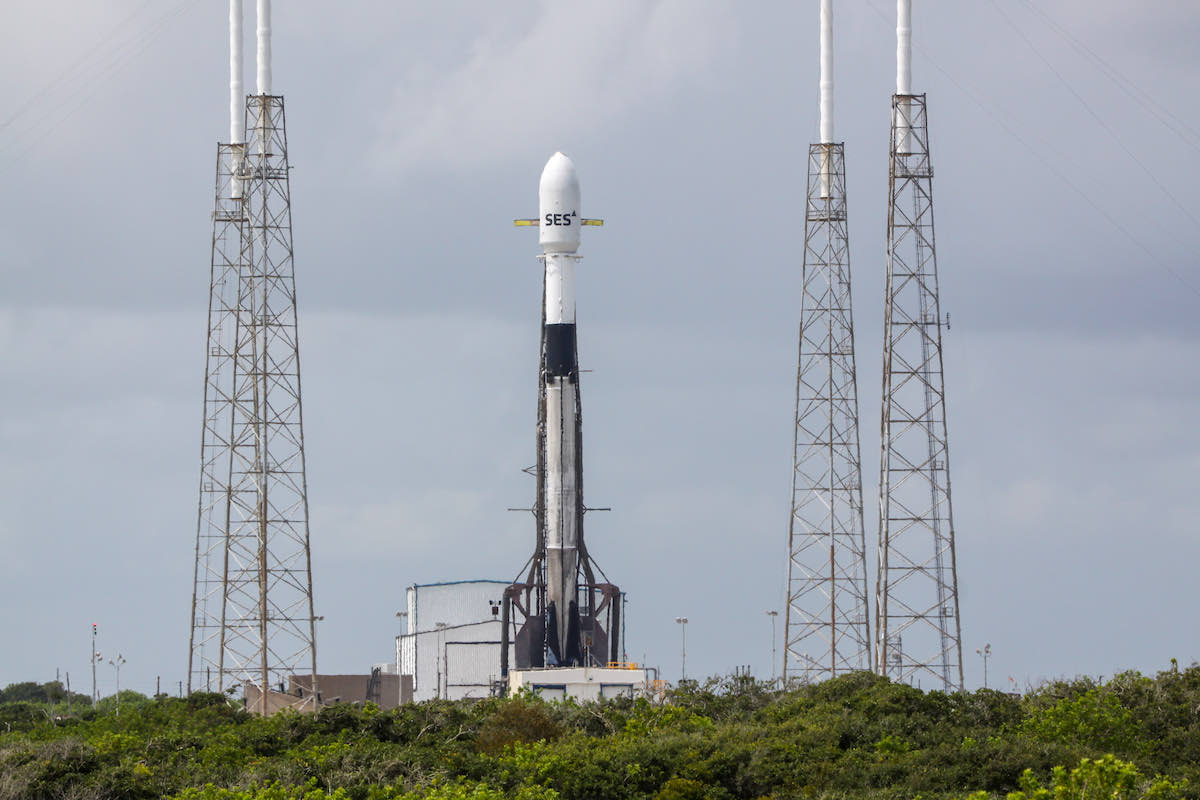
SpaceX has pushed back the flight of its next Falcon 9 rocket from Tuesday to Saturday as Subtropical Storm Nicole threatens the east coast of Florida, officials said Monday. But NASA is keeping its Artemis 1 moon rocket on the launch pad at Kennedy Space Center in preparation for a launch attempt next week.
The next Falcon 9 rocket launch was scheduled for a two-hour window opening at 11:06 a.m. EST (1606 GMT) Tuesday from pad 40 at Cape Canaveral Space Force Station. SpaceX is now targeting the launch for Saturday at about the same time with Intelsat’s Galaxy 31 and 32 commercial communications satellites.
“Teams at the Cape are preparing for Tropical Storm Nicole and are now targeting no earlier than Saturday, November 12, for Falcon 9’s launch of the Intelsat G-31/G-32 mission to orbit from SLC-40,” SpaceX said in a tweet Monday. “The vehicle and payload are secure in the hangar and will remain there through the duration of the storm.”
The launch will deploy the Galaxy 31 and 32 satellites, stacked one on top of the other, into a geostationary transfer orbit for Intelsat. The satellites will provide C-band television broadcast services across the United States, continuing Intelsat’s program to clear C-band spectrum under a Federal Communications Commission directive to convert some C-band frequencies used in satellite video broadcasting to terrestrial cell phone services.
Intelsat and SES, two of the largest communications satellite operators for video services, ordered new spacecraft to cover a more narrow portion of the C-band spectrum. SES has launched three new C-band satellites this year, and Intelsat sent two into orbit on a Falcon 9 rocket in October, with more to come.
SpaceX will expend the booster on the Falcon 9 rocket for the Galaxy 31/32 mission. Intelsat officials said the company paid SpaceX an extra fee to devote all of the rocket’s propellant to boosting the satellites into a higher orbit, closer to their final operating position. The tradeoff means the Galaxy 31 and 32 satellites will be able to enter commercial services months sooner than if the SpaceX booster reserved some of its propellant for landing.
The mission will mark SpaceX’s 52nd launch of the year, with roughly a dozen Falcon rocket missions will on the schedule before the end of 2022.
Meanwhile, a few miles to the north of pad 40, NASA’s Artemis 1 moon rocket is being prepared for a launch attempt as soon as Nov. 14 to begin a long-delayed unpiloted test flight. NASA’s human-rated Orion spacecraft will separate from the rocket and enter orbit around the moon for a series of checkouts before the agency commits to flying astronauts on the next SLS/Orion mission.

NASA said Monday that managers have decided to keep the 322-foot-tall (98-meter) Artemis 1 moon rocket on Launch Complex 39B as Subtropical Storm Nicole approaches Florida. NASA rolled the rocket back to the launch pad Friday after moving it back into the Vehicle Assembly Building in late September to take shelter from Hurricane Ian.
“Based on current forecast data, managers have determined the Space Launch System rocket and Orion will remain at Launch Pad 39B,” NASA said in a statement Monday. “Teams at Kennedy will continue to monitor the weather, make sure all personnel are safe, and will evaluate the status of the Monday, Nov. 14, launch attempt for the Artemis 1 mission as we proceed and receive updated predictions about the weather.”
As of 10 a.m. EST (1500 GMT) Monday, the National Hurricane Center predicts Subtropical Storm Nicole could become a hurricane as it moves west over the Atlantic Ocean toward Florida, potentially making landfall south of Cape Canaveral late Wednesday or early Thursday. The storm had maximum sustained winds of 45 mph Monday morning.
Pad 39B does not have a moveable gantry to protect the SLS moon rocket, but the giant vehicle is designed to withstand wind gusts up to 85 mph, or 74 knots, at the launch facility.
If the bad weather this week doesn’t delay launch preparations, NASA hopes to start a two-day countdown Saturday culminating in a launch opportunity for Artemis 1 during a 69-minute window opening Monday at 12:07 a.m. EST (0507 GMT). NASA has penciled in backup launch attempts Nov. 16 and 19, and the current launch period runs until Nov. 27.
Email the author.
Follow Stephen Clark on Twitter: @StephenClark1.
from Spaceflight Now https://ift.tt/tVLrDnE
via World Space Info







0 comments:
Post a Comment